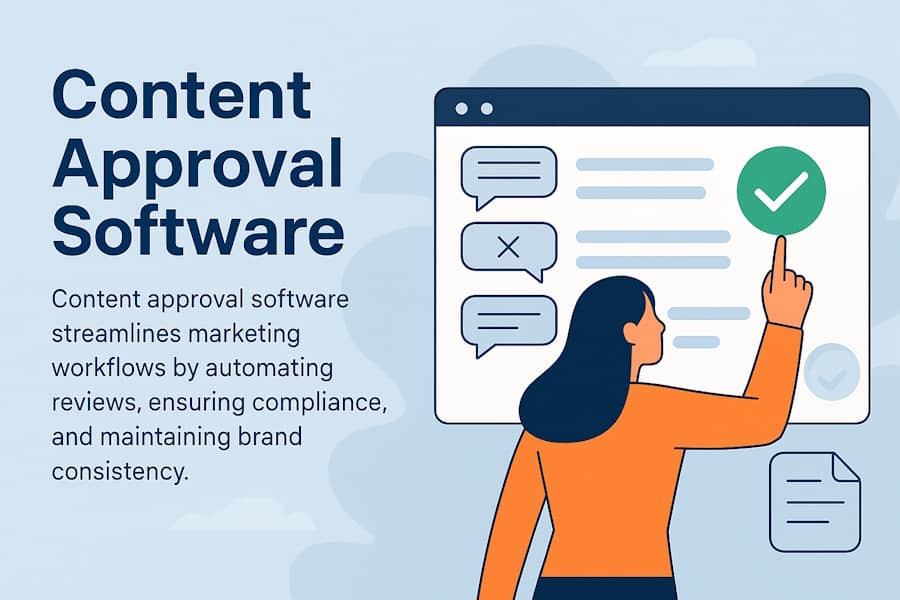Every great marketing campaign begins with an idea — and ends with approval. Between those two points lies a maze of drafts, comments, and revisions. When that maze grows without structure, consistency, and compliance starts to crumble. Content approval software turns that chaos into clarity — and makes scale possible without sacrificing control.
Why Manual Approval Fails at Scale
Slow Review Cycles
As teams grow, so does the number of stakeholders. Each reviewer adds time — and potential delay. What used to be a quick “yes” on Slack turns into a week-long chain of conflicting comments. The result? Missed deadlines and creative fatigue.
Manual review depends on human bandwidth. When deadlines tighten, reviews get skipped, approvals go undocumented, and mistakes slip through. Eventually, teams start to confuse “fast” with “done.”
Lost Feedback Threads
Email-based reviews scatter context. A designer receives one version of feedback; the writer gets another. No one is sure which comment applies to which draft. The absence of a single source of truth creates duplication, confusion, and resentment between departments.
Worse, when a campaign later needs auditing or updating, there’s no record of who approved what — an operational and compliance nightmare.
Compliance Errors from Human Oversight
Manual workflows rely on memory. Did we include the disclaimer? Did you do a legal review of that copy? In regulated industries, a forgotten clause or outdated claim can mean fines, not just edits.
Even for non-regulated brands, inconsistent messaging weakens credibility. Manual systems simply can’t track hundreds of assets across teams and platforms reliably.
What Is Content Approval Software?
Core Features and Benefits
Content approval software centralizes the review and sign-off process for marketing materials. It allows every stakeholder — from copywriters to legal teams — to collaborate within one structured workflow.
Common capabilities include:
- Real-time commenting and version control.
- Automated routing to the right approvers.
- Audit trails documenting every decision.
- Integration with content creation tools.
By creating a unified approval environment, brands eliminate confusion and gain visibility. Approvals become faster, cleaner, and fully traceable.
How It Fits in Modern Workflows
In the era of remote work and distributed marketing, centralized visibility is everything. Content approval platforms integrate directly with CMS, DAM, and project management systems so that reviews happen where the work lives.
Writers submit drafts, designers upload visuals, and compliance officers review them — all in the same environment. Notifications replace long email chains, and everyone sees progress in real time.
Key Metrics to Evaluate Software
When choosing a platform, focus on measurable impact:
- Turnaround time: average hours between submission and final approval.
- Revision cycles: how many edits per asset before sign-off.
- Error rate: how often non-compliant assets slip through.
- Adoption rate: how many teams actually use the system daily.
These metrics reveal whether technology is truly solving problems or just adding another layer of process.
How Automation Improves Compliance
Automated Rule Enforcement
Automation transforms approval from reactive to preventive. Pre-set rules can flag content that violates brand tone, uses restricted phrases, or omits required disclaimers.
For example, if a piece of copy lacks a legal disclosure or uses an off-brand color, the system can automatically stop it from moving forward until corrected. This proactive filter reduces human error and ensures only compliant assets reach the audience.
Real-Time Notifications
Instant alerts keep reviews moving. When legal approves a clause or a manager requests a revision, the software notifies everyone involved. No more “lost in inbox” excuses.
Transparency motivates action — reviewers know their deadlines, and creators can track status without chasing updates. In large organizations, these micro-efficiencies compound into massive time savings.
Integrated Audit Trails
Every approval, comment, and edit is recorded automatically. During audits or disputes, teams can trace who approved what and when.
For regulated sectors — finance, healthcare, or pharmaceuticals — this record is more than convenience; it’s proof of compliance. For agencies, it’s documentation that protects client relationships.
Automation doesn’t remove human judgment; it removes ambiguity.
Implementation Tips for Large Teams
Introducing a new system always triggers resistance. Here’s how to smooth adoption:
- Start small. Pilot the software with one campaign or department before scaling. Early wins help prove value.
- Customize workflows. Tailor approval paths to reflect real organizational hierarchies. One size never fits all.
- Train for trust. Show teams how automation supports creativity, not replaces it. Emphasize saved time, not surveillance.
- Measure success visibly. Share data on faster turnarounds and fewer errors — metrics convince skeptics faster than promises.
Over time, habits shift from “Did you email that for approval?” to “It’s in the system — check the dashboard.” That’s when culture catches up to technology.
Integrating Approval Workflows with Compliance Goals
Aligning Creative and Legal Standards
Approvals are not just sign-offs; they’re opportunities for alignment. When creative and legal teams collaborate early, campaigns evolve with compliance built in — not bolted on.
Legal can highlight regulatory red flags before production; creative can explain artistic intent behind risky phrases. The goal isn’t to avoid rules but to design confidently within them.
Bridging Tools and Data Silos
Modern marketing stacks often sprawl — CRM here, CMS there, chat elsewhere. Integrating approval tools across these systems turns data into insight. Managers can track which content types face the most rework or where bottlenecks occur.
This visibility allows continuous improvement rather than endless firefighting.
Scaling Without Losing Consistency
As organizations expand globally, consistent messaging becomes harder. Content approval platforms standardize expectations. Whether a team works in New York or Singapore, the process and checks remain identical.
That consistency protects the brand while allowing localization. Campaigns can adapt language and imagery for local markets without diluting identity.
Case in Point: Digital Content Approval in Practice
Imagine a multinational retailer launching seasonal campaigns across 15 countries. Each market adapts copy, pricing, and imagery, but all assets must comply with brand and legal guidelines.
Without centralized control, the process would collapse under version chaos. With digital content approval, assets flow through predefined paths:
- Designers upload variations.
- Local legal teams verify regional requirements.
- Global brand managers approve final visuals.
Everyone works in sync, seeing real-time status and history. Launches hit deadlines; compliance stays airtight.
This is the difference between coordination and collaboration — between guessing and knowing.
The ROI of Content Approval Software
Automation pays for itself in time and risk reduction. Organizations often see:
- 30–50% faster campaign turnaround.
- Fewer compliance incidents thanks to automated checks.
- Improved morale — fewer last-minute scrambles and unclear responsibilities.
- Audit readiness — instant access to version histories.
More importantly, structured approvals enable growth. Teams can scale output confidently, knowing governance grows with them.
Summary: Scale Without Losing Control
Scalability demands structure. Without it, creative velocity turns into chaos. Content approval tools act as the backbone of modern marketing governance — keeping brand integrity intact as campaigns multiply.
They unify collaboration, automate oversight, and embed compliance into everyday work. That integration turns approval from a bottleneck into a strategic advantage.
For organizations serious about sustainable growth, investing in content approval software isn’t optional — it’s foundational.
Conclusion
Compliance is not the enemy of creativity; it’s its most reliable partner. In a digital world where every message is public and permanent, structured approval protects both the brand and the people who build it.
Manual processes crumble under scale. Spreadsheets can’t safeguard reputation. But with clear workflows, transparent accountability, and automated checks, brands can grow confidently — balancing imagination with integrity.
The future belongs to teams that move fast and stay compliant. And that future starts with rethinking approvals not as bureaucracy, but as the infrastructure of trust.








